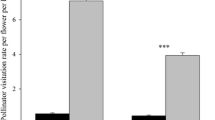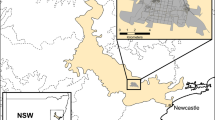Abstract
The reproductive success of three co-flowering species ofVaccinium (V. myrtillus, V. vitis-idaea andV. uliginosum) was studied in one heathland of the Upper Ardennes, Belgium, during three years (1988–1990). The purpose was to examine whether pollen limitation, flower position and flowering phenology may influence patterns of fruit set in these three sympatric species. I quantified fruit and seed set following supplementary hand-pollinations and compared this to natural fruit set. On the same plants, I also quantified fruit and seed set in relation to the spatial position of the flowers on the ramet and their temporal sequence of blooming. Hand-pollination had no significant effect on fruit set inV. vitis-idaea andV. uliginosum, but significantly increased seed number per fruit in 1989. InV. myrtillus both fruit and seed set were increased by supplementary pollination, but significantly in only one year. Analyses of position effects revealed that the fruits in the lower positions in the ramet did not mature preferentially and did not contain more seeds inV. uliginosum and inV. vitis-idaea. Flowering phenology also had no significant effect for these species. InV. myrtillus hand-pollinated flowers showed a seasonal decline in seed number, and control (naturally pollinated) flowers showed a seasonal increase in fruit set. Fruit and seed set appear to be pollen-limited rather than resource-limited inV. uliginosum. In the two other species, unfavorable weather (frosts) could be a more important cause of low fruit and seed set.
Similar content being viewed by others
References
Ägren, J., 1988: Between-year variation in flowering and fruit set in frost-prone and frost-sheltered populations of dioeciousRubus chamaemorus. — Oikos76: 175–183.
Belonogova, T.V., 1988: Yield forecasting and optimization of berry harvesting in the forests of Southern Karelia USSR. — Acta Bot. Fenn.136: 19–21.
Bierzychudek, P., 1981: Pollinator limitation of plant reproductive effort. — Amer. Naturalist117: 838–840.
Burd, M., 1994: Bateman's principle and plant reproduction—The role of pollen limitation in fruit and seed set. — Bot. Rev.60: 83–139.
Campbell, D. R., Halama, K. J., 1993: Resource and pollen limitations to lifetime seed production in a natural plant population. — Ecology74: 1043–1051.
Cane, J. H., Eickwort, G. C., Wesley, F. R., Spielholz, J., 1985: Pollination ecology ofVaccinium stamineum (Ericaceae, Vaccinioidae). — Amer. J. Bot.72: 135–142.
Casper, B. B., Niesenbaum, R. A., 1993: Pollen versus resource limitation of seed production: A reconsideration. — Curr. Sci.65: 210–214.
Dudash, M. R., 1993: Variation in pollen limitation among individuals ofSabatia angularis (Gentianaceae). — Ecology74: 959–962.
Ehrlén, J., 1991: Why do plants produce surplus flowers—A reserve-ovary model. — Amer. Naturalist138: 918–933.
Feldman, J. D. S., Hoffman, R., Gagnon, J., Simpson, J., 1987: Statview SE + Graphics. — Berkeley Abacus Concepts Inc.
Flowers-Ellis, J. G. K., 1971: Age structure and dynamics in stands of bilberry (Vaccinium myrtillus L.). — Avdel. Skoqs. Stockholm Rapp. Uppsater9: 1–108.
Jacquemart, A.-L., 1993a: Floral visitors ofVaccinium species in the High Ardennes, Belgium. — Flora188: 263–273.
, 1993b: Ecologie du système reproducteur chez trois espèces deVaccinium en haute Ardenne. — Ph. D. Thesis, University of Louvain, Louvain-la-Neuve, Belgium.
, 1996: Floral and pollination biology of three sympatricVaccinium species in the Upper Ardennes, Belgium. — Canad. J. Bot.74: 210–221.
Karoly, K., 1992: Pollinator limitation in the facultatively autogamous annualLupinus nanus (Leguminosae). — Amer. J. Bot.79: 49–56.
Kuchko, A. A., 1988: Bilberry and cranberry yields and the factors controlling them in the forests of Karelia USSR. — Acta. Bot. Fenn.136: 23–25.
Lee, T. D., 1988: Patterns of fruit and seed production. — InLovett-Doust, J., Lovett-Doust, L., (Eds): Plant reproductive ecology: patterns and strategies, pp. 179–203. — New York: Oxford University Press.
Lehmushovi, A., 1977: Some aspects of the cowberry trials in Finland. — Ann. Agric. Fenniae16: 57–63.
Motten, A. F., 1986: Pollination ecology of the spring wildflower community of a temperate deciduous forest. — Ecol. Monogr.56: 21–42.
Primack, R. B., Hall, P., 1990: Costs of reproduction in the pink lady's slipper orchid: a four-year experimental study. — Amer. Naturalist136: 638–656.
Rathcke, B., 1988: Interactions for pollination among coflowering shrubs. — Ecology69: 446–458.
Ritchie, J. C., 1955: Biological flora of the British Isles:Vaccinium vitis-idaea L.-J. Ecol.43: 701–708.
, 1956: Biological flora of the British Isles:Vaccinium myrtillus L.-J. Ecol.44: 291–299.
Stephenson, A. G., 1981: Flower and fruit abortion: proximal causes and ultimate function. — Annual Rev. Ecol. Syst.12: 253–279.
Sutherland, S., 1987: Why hermaphroditic plants produce many more flowers than fruits: experimental tests withAgave mckelveyana. — Evolution41: 750–759.
Vaughton, G., 1991: Variation between years in pollen and nutrient limitation of fruit set inBanksia spinulosa. — J. Ecol.78: 389–400.
Warming, E., 1908: The structure and biology of Arctic flowering plants. I.Ericineae. I. Morphology and biology. — Meddel. Grønland36: 1–71.
Waser, N. M., 1983: Competition for pollination and floral character differences among sympatric plant species: a review of evidence. — InJones, C. E., Little, R. J., (Eds): Handbook of experimental pollination ecology, pp. 227–293. — New York: Van Reinhold.
Wyatt, R., 1983: Pollinator-plant interactions and the evolution of breeding systems. — InReal, L., (Ed.): Pollination biology, pp. 51–96. — New York: Academic Press.
Author information
Authors and Affiliations
Rights and permissions
About this article
Cite this article
Jacquemart, A.L. Pollen limitation in three sympatric species ofVaccinium (Ericaceae) in the Upper Ardennes, Belgium. Pl Syst Evol 207, 159–172 (1997). https://doi.org/10.1007/BF00984387
Received:
Revised:
Accepted:
Issue Date:
DOI: https://doi.org/10.1007/BF00984387




